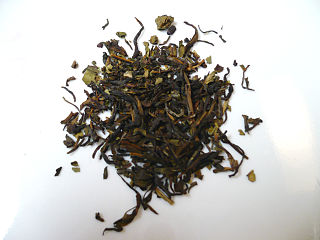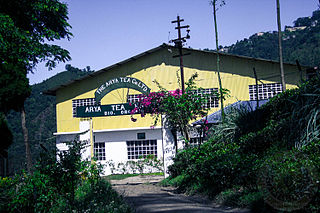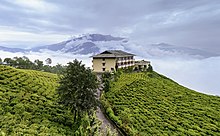
Cardamom, sometimes cardamon or cardamum, is a spice made from the seeds of several plants in the genera Elettaria and Amomum in the family Zingiberaceae. Both genera are native to the Indian subcontinent and Indonesia. They are recognized by their small seed pods: triangular in cross-section and spindle-shaped, with a thin, papery outer shell and small, black seeds; Elettaria pods are light green and smaller, while Amomum pods are larger and dark brown.

Sikkim is a state in northeastern India. It borders the Tibet Autonomous Region of China in the north and northeast, Bhutan in the east, Koshi Province of Nepal in the west, and West Bengal in the south. Sikkim is also close to the Siliguri Corridor, which borders Bangladesh. Sikkim is the least populous and second smallest among the Indian states. Situated in the Eastern Himalaya, Sikkim is notable for its biodiversity, including alpine and subtropical climates, as well as being a host to Kangchenjunga, the highest peak in India and third highest on Earth. Sikkim's capital and largest city is Gangtok. Almost 35% of the state is covered by Khangchendzonga National Park – a UNESCO World Heritage Site.

Nilgiri tea is a drink made by infusing leaves of Camellia sinensis that is grown and processed in the Nilgiris district in Tamil Nadu, India. The leaves are processed as black tea, though some estates have expanded their product offerings to include leaves suitable for making green, white and oolong teas. It is generally described as being a brisk, fragrant and full-bodied tea. The region produces both rolled and crush, tear, curl tea and it is predominantly used for blending. Nilgiri tea is also used for making iced tea and instant tea.

Namchi is a city and the administrative headquarter of the Namchi district in the Indian state of Sikkim. The appellation Namchi means Sky (Nam) High (Chi) in Sikkimese.

Darjeeling tea is a tea made from Camellia sinensis var. sinensis that is grown and processed in Darjeeling district or Kalimpong district in West Bengal, India. Since 2004, the term Darjeeling tea has been a registered geographical indication referring to products produced on certain estates within Darjeeling and Kalimpong. The tea leaves are processed as black tea, though some estates have expanded their product offerings to include leaves suitable for making green, white, and oolong teas.
Tinkitam is a small town in Namchi, India. The town is located 45 minutes from the district headquarters Namchi. The town is being promoted as a tourist destination. Mount Kanchenjanga is near the town.
In the cuisine of Sikkim, in northeastern India, rice is a staple food, and fermented foods traditionally constitute a significant portion of the cuisine. Indian cuisine is popular, as Sikkim is the only state of India with an ethnic Indian Gorkha majority. Many restaurants in Sikkim serve various types of Nepalese cuisine, such as the Limbu, Newa and Thakali cuisines. Tibetan cuisine has also influenced Sikkimese cuisine. The combination of various cuisines has resulted in one specific cuisine.

India is one of the largest tea producers in the world, although over 70 percent of its tea is consumed within India itself. A number of renowned teas, such as Assam and Darjeeling, also grow exclusively in India. The Indian tea industry has grown to own many global tea brands and has evolved into one of the most technologically equipped tea industries in the world. Tea production, certification, exportation and all facets of the tea trade in India are controlled by the Tea Board of India.

Arya Tea Estate is a tea garden in the Darjeeling Pulbazar CD block in the Darjeeling Sadar subdivision of the Darjeeling district in West Bengal, India
Goodricke Group Limited is an India-based tea producing company headquartered in West Bengal. It is a part of the Camellia PLC UK – the world's largest private sector tea producer. The four tea producing companies in its fold include Goodricke Group Limited, Stewart Holl (India) Limited, Amgoorie India Limited and Koomber Tea Co. Pvt. Limited. The Group owns 30 gardens and 27 tea factories spread over Darjeeling, Dooars, Assam and Cachar. In recent years the Goodricke Group acquired in Assam two estates of the McLeod company being in economic difficulties. The major Darjeeling brands include Goodricke Castleton, Roasted and Margaret's Hope, while the Black (CTC) tea includes Goodricke Khaass, Goodricke Zabardast and Goodricke Chai.

Sikkim tea is a variety of tea grown in the state of Sikkim, India. Though Sikkim tea is not as widespread in use as the neighboring Darjeeling tea, it has recently gained more recognition from the increasing demand for organic products. The tea is mostly sold under the marketing name 'Temi tea'. After Darjeeling tea became the first Indian product to receive a GI tag, Sikkim's Temi tea has been waiting to receive the same.
Sungma Tea Garden is spread over two villages - Sangmaru Tea Garden (Sungma) and Tarzun Tea Garden in the Jorebunglow Sukhiapokhri CD block in the Darjeeling Sadar subdivision of the Darjeeling district in the state of West Bengal, India.
Rishihat Tea Garden is a village in the Darjeeling Pulbazar CD block in the Darjeeling Sadar subdivision of the Darjeeling district in the state of West Bengal, India.
Orange Valley Tea Garden is a village in the Darjeeling Pulbazar CD block in the Darjeeling Sadar subdivision of the Darjeeling district in the state of West Bengal, India.
Singbulli Tea Garden is a village in the Mirik CD block in the Mirik subdivision of the Darjeeling district in the state of West Bengal, India.
Balasun Tea Estate is a tea garden in the Kurseong CD block in the Kurseong subdivision of the Darjeeling district in the Indian state of West Bengal.
Nagri Farm Tea Garden is a village in the Jorebunglow Sukhiapokhri CD block in the Darjeeling Sadar subdivision of the Darjeeling district in the state of West Bengal, India.
Aryaman Tea Estate is a tea garden, located in the Madarihat-Birpara CD block in the Alipurduar subdivision of the Alipurduar district in the Indian state of West Bengal.

Rajah Banerjee, or Swaraj Kumar Banerjee, is a tea planter, environmentalist and a writer, best known for his stewardship of his ancestral Makaibari Tea Estate in Darjeeling. His family was the proprietor of Makaibari Tea Estate from 1859 to 2017, and he was the fourth generation manager of Makaibari. He is a pioneer of the organic movement in Darjeeling. Under his guardianship, Makaibari was made organic and bio - dynamic. He is famous for his unique Silver Needle Moonlight Plucked Teas, which is only plucked at midnight on a full moon's night during the spring season, in Darjeeling.

The economy of Sikkim, a state in northeastern India, has a significantly agricultural economy. Although having mountainous terrain, Sikkim has managed to sustain its agricultural economy through organic farming. The state of Sikkim was declared as the only 100 per cent organic state in 2016. Sikkim's industrial sector is also mostly agriculture based. Besides agriculture, other large industries include pharmaceuticals, ecotourism, and carpet weaving.












